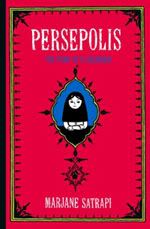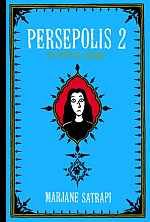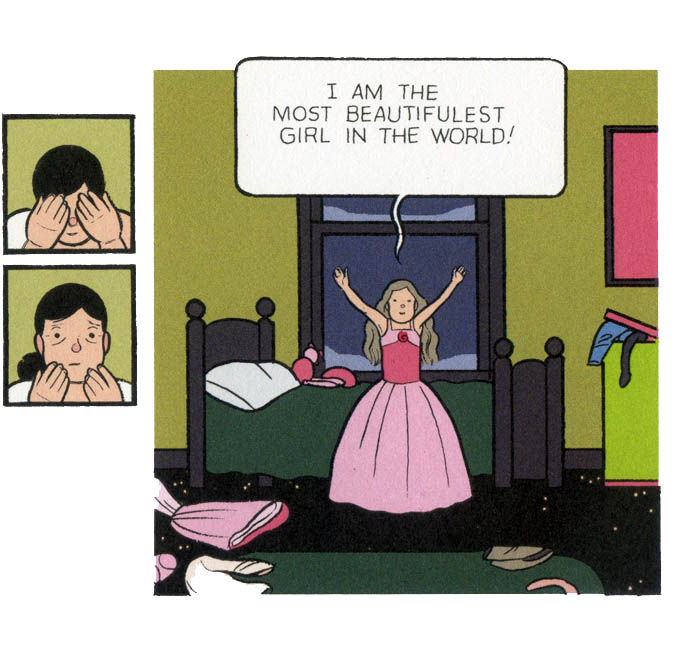Per·sep·o·lis ( P ) Pronunciation Key (pr-sp-ls)
An ancient city of Persia northeast of modern Shiraz in southwest Iran. It was the ceremonial capital of Darius I and his successors. Its ruins include the palaces of Darius and Xerxes and a citadel that contained the treasury looted by Alexander the Great.
But the Persepolis I am talking about now is an autobiography, written by an Iranian lady named Marjane Satrapi, and needless to say, the medium she chooses to recount the story of her life is the Comic Book. It worked well, the original French publication earning quite a lot of accolades, and Pantheon Books brought out the English version of the book last year, as a beautifully designed hardcover. I learnt about it from Tom Arnold’s review in time.com, and after noticing it in the stores, bought it. Loved it immensely – the combination of the honest childs-eye-view of the proceedings in Iran and Ms Satrapi’s deceptively simple artwork gave me goosepimples, an aching heart and a smile on my face all at the same time. So did a lot of other people I lent the book to.
I was lucky enough to find the book at Walden a couple of days ago, a single copy, when I was searching for Jonathan Strange and Mr Norrell, and yesterday I bought it. I finished reading it just now.
Truth be told, I want to read it again. With a slightly more detailed look at the artwork – it is both sparse and striking at the same time, the depth of emotion this lady can bring to a face with a couple of black-and-white lines is just incredible. The cover design is the same as that of the first time ( see below), except for the colour, and the fact that the woman we see in the picture is an adult. My only complaint with the book lies in the fact that some of the ink seems to be smudged at certain pages. Whether this is a problem with my copy or whether Random House goofed up during the printing process I shan’t know.


The story continues from ‘Memoirs of a Childhood’, from where the teenaged Marjane leaves her parents behind in Iran and comes to Vienna to study. It’s tough going for her, as she faces resentful relatives, sullen nuns, unhelpful classmates and worst of all, a language barrier. “Every morning, I was rudely awakened by the sound of Lucia’s hair dryer”, she says, Lucia being her roommate, “Woken by a hair dryer to return to a school where I had no friends. ” But slowly, she accustoms herself to the new life, earns quite a few friends, reads Simone de Beauvoir and tries to pee standing up and then proceeds to get herself thrown out of boarding school.
Her life changes again, as she begins to stay with a friend. A hilarious introduction to the wild partying scene follows ( “..the party was not exactly what I imagined. In Iran, at parties, everyone would smoke and eat. In Vienna, people preferred to lie around and smoke. And then, I was turned off by all these public displays of affection. What do you expect, I came from a traditional country.”) Her mental transformation by all those cultural differences is followed by her physical growth – “between the age of fifteen and sixteen, I grew seven inches. It was impressive.” At the same time, Marjane is slipping away from her own cultural background, at times even denying her Iranian origin to her peers.
The book is hilarious and serious by turns, like the way Marjane’s mother( who she meets after nineteen months) takes to her eight gay roommates, and how the two women bond again. The story continues at a perfect pace, not skimming over the details of Marjane’s first love and heartbreak, and her near-fatal encounters with dope, after which she decides to come back to Iran.
The second half of the book is all the more fascinating, because the eyes of the child-Marjane are now replaced by those of the woman, and we receive an adult’s point of view of Iranian society. Her rebonding ( reluctant!) with her relatives, the cultural clashes that her Western years have brought her, and the price she has to pay for being outspoken and fearless ( which, sometimes, did hold her in good stead, even in Iran)
The book ends the same way as the first did, with a tearful farewell between Marjane and her parents and her grandmother, as she leaves Iran again, leaving behind a broken marriage and a life of strict laws. “The laws of Iran are not for you.”, her mother tells her, “I forbid you to come back.” But freedom has a price, as Marjane tells us, because she saw her grandmother only once again in her lifetime, a year later – and she died after two years.
All in all, Persepolis 2 is an honest book, a book I would love to reread from time to time on lonely afternoons. It might not have broken my heart the way the first book did, but it did bring quite a few smiles on my face. It is easy to think you know Marjane Satrapi after you’ve read Persepolis, but to know and understand how a couple of years can change a human being, any human being, for that matter, read Persepolis 2. It’smore personal that the first one was – I wonder how the actual people in the book must feel when they see themselves in it, and Ms Satrapi does not flatter anyone, including herself.
I only hope there will be more books forthcoming from the lady.
India-centric Trivia: The English translation of The Story of a Return is by a lady named Anjali Singh.

Never new Shiraz is a city name and was the capital of pursia. I only knew of Shiraz grape (particularly australian). Thanks for the info!
I never knew of a grape called Shiraz. :-)
Thank you. Convinced.
So when are you buying it? :)
I just finished “Persepolis”, recently, and it was awesome! I only skimmed your entry, since I have “Persepolis 2” on hold at the library (not in, yet, though). I agree, that the story was engrossing enough that it was actually a bit hard to give the illustrations as much attention as they probably deserved.
You’d probably like “Reading Lolita in Tehran”, beatzo… Though there aren’t as many pictures in it as there are in most of your books. ;)
I have been seeing you recommend “Reading Lolita in Tehran” for quite sometime on your lj, and believe me, I’ve been keeping an eye out for it. It’s available at the bookstall, but the price is a little too high – I am waiting for the old-stock/second-hand stall people to get it, or a sale at the regular bookstore. :)